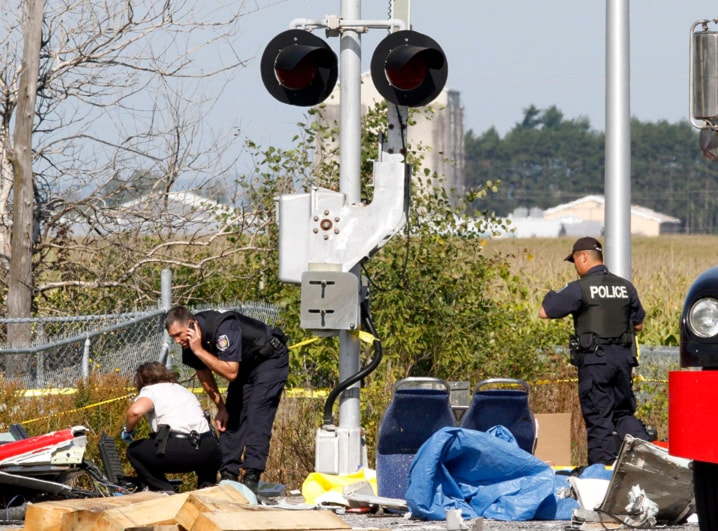OTTAWA — Police and accident investigators prowled the crumpled wreck of a city bus Thursday, seeking clues as to why it crashed through a safety barrier and slammed into a Via Rail train the day before, killing six people.
Just west of the bus, rail workers toiled to replace tracks bent out of alignment by the subsequent derailment of the locomotive and one of its four passenger cars.
City crews spent much of the day picking up debris from around the crash site.
Meanwhile, police formally identified the dead as Michael Bleakney, 57; Connor Boyd, 21; Karen Krzyzewski, 53; Kyle Nash, 21; and Rob More, 35. Bus driver Dave Woodard, 45, was also killed in the crash.
“Our thoughts are with the victims, their friends and families,” the police news release said.
Five of the victims were pronounced dead at the scene; one died later in hospital.
Boyd and Nash were students at Carleton University. Roseann O’Reilly Runte, the university’s president and vice-chancellor, offered condolences.
“The loss of such young people, who were in the prime of their lives, will touch us in many ways,” she said. “Our thoughts are also with those individuals who were injured and witnessed this terrible accident.”
Transportation Safety Board investigators said they recovered data recorders from the bus and locomotive.
Lead investigator Rob Johnston said the locomotive’s recorder was shipped overnight to Montreal, where its data was downloaded. The information is being studied.
The device from the bus presents a challenge, however.
“The event recorder information on vehicles is specific to each type of vehicle and to whoever the owner of that vehicle is, so it’s not always the same,” Johnston said.
“It’s not like on a locomotive, where a locomotive event recorder captures specific data and we know exactly what to look for.”
Automobile recorders capture different kinds of information, he added. “At this point we’re just trying to see what we have.”
Although many Via locomotives carry a front-end camera, this one hadn’t yet been equipped with one, he said.
“Unfortunately, this was one of the last ones to get changed over and that has happened yet.”
Johnston wouldn’t speculate about possible mechanical failures on the bus that might have been a factor. “We’re doing a detailed and thorough analysis of that bus as we are with all the other facets in our investigation.”
He said it will take time to figure out why Woodard drove the crowded bus through a lowered safety barrier and into the flank of the locomotive just east of a small Via station in the western suburbs.
Witnesses said the northbound bus didn’t stop as lights flashed, bells rang and guard barriers dropped across the road at the approach of the train, which was slowing to stop at the station a few hundred metres west.
Passengers on the bus frantically shouted “Stop! Stop!” seconds before the impact.
Colleagues have described Woodard as a conscientious driver and a good workmate.
The bus was on a transitway dedicated to bus traffic. The roadway remains closed, forcing transit buses onto regular streets and prompting warnings of schedule delays because of extra traffic.
The forlorn double-decker bus sat by the tracks Thursday, its shattered front end a glaring reminder of the devastating impact that sheared away steel and glass.
The site drew at least one survivor back for a second look.
Romi Gupta, a 40-year-old downtown office worker, returned with her husband to see it again.
She said she has neck and back pain and a wound on her arm as a result of the crash, but she shrugged off the pain.
“It’s nothing compared to what other people have been through,” she said.
